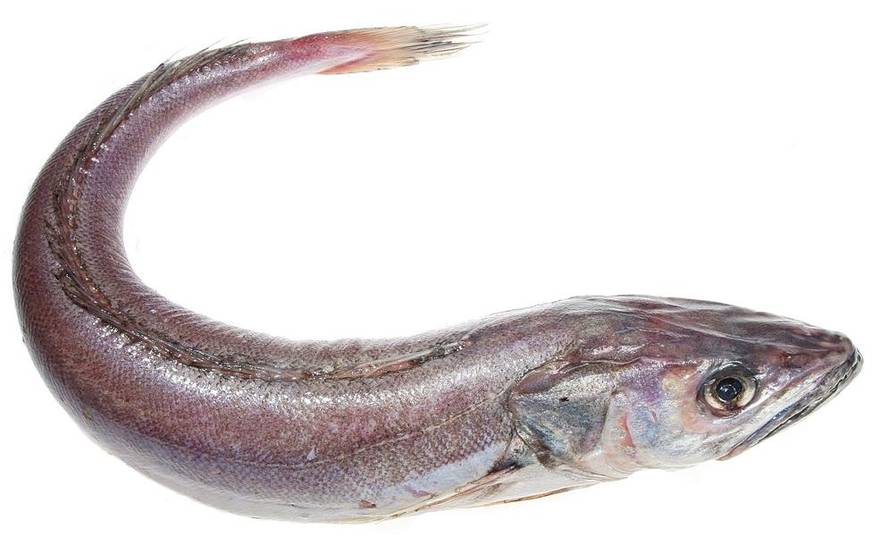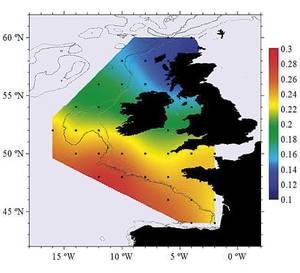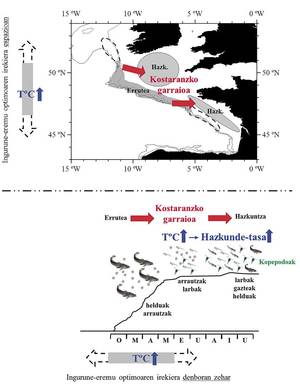Hake in debt to nature
Along with other fish associated with the seabed, such as the monkfish or the rooster, hake is a highly appreciated species. Especially in Euskal Herria, being one of the main actors of the local gastronomic scene. Thus, historically, the population of European hake has suffered a strong fishing pressure on the European waters of the Atlantic. In the second half of the 1980s, death by fishing skyrocketed, bringing the biomass of the stock down significantly. In addition, in the 1990s, the stock was constantly exploited, although biomass was at very low levels. However, the population of European hake has resisted fishing pressure, which has led to a healthier situation.
This being the case, the question that we ask ourselves around the head is: What factors have pushed the population of hake to get out of this difficult situation and to climb on a slope? Thus, in the doctoral thesis carried out in AZTI-Tecnalia and in the UPV the population dynamics of European hake have been investigated and the influence of environmental parameters has been analyzed between 1978-2006. In addition, the causes of the vulnerability of hake have been identified in the first phases of life.
Worsen fishing, correct nature
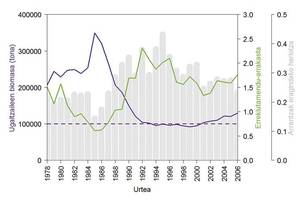
The population of European hake is suffering a destructive fishing in the European waters of the Atlantic. This overfishing is a critical factor in the decline in stock, often to the collapse of the population. Specifically, fishing has exerted great pressure on the population of European hake in the north. In the second half of the 1980s, hake fishing increased, which led to a sharp decline in stock biomass. In the 1990s the stock was continuously exploited, although biomass is at a very low level. In fact, at this time the biomass of the reproductive stock (parental biomass) was in a precarious situation, reaching even below the limit of 100,000 tons. Below this reference value, the risk of recruitment failure is high, that is, that those of the next generation do not become adults. In such low values, the sensitivity of stock increases to environmental conditions, so adverse environmental factors could lead the hake stock to an even worse situation. However, despite the decline in the biomass of reproducers, a large proportion of the descendants of these few parents managed to survive, which led to a sharp increase in recruitment success in the 1990s. This would probably compensate for the reduction of stock and avoided collapse. Thus, recruitment and biomass of reproducers have been recovered recently, after remaining for a long period of time at low levels. We can conclude that the northern hake stock is in a more relaxing situation. This thesis suggests that nature played an important role in this impulse and, along with the decrease in fishing, we present it as the reason for the recovery of hake.
Generation after generation, place of climate
The exploitation makes marine species more sensitive to the climate. In fact, in extreme situations, the dynamics of the population depends in part on the fluctuations of recruitment by effect of fishing, while the survival of larvae and young people is conditioned, mainly, by the environmental conditions. Therefore, it is of great importance to analyze to what extent the natural climate changes affect marine ecosystems. With this objective, a series of oceanographic and meteorological parameters were selected and their influence was analyzed in different geographical scales: at a global level (in the north of the Atlantic Ocean), regional (in the distribution area of the European northern hake), as well as local (in the start-up and growth zones).
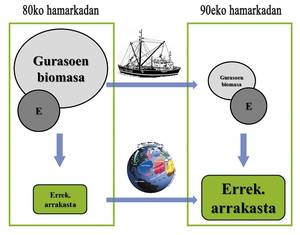
In the case of hake, it is observed that from the 1990s, favorable environmental conditions have been given over the previous decade. However, this change in environmental conditions has not occurred progressively. Specifically, there was an ecological regime change on the continental shelf of the northeast of the Atlantic Ocean during the years 1988-89, as suggested by this paper. Since that change, the NAO index ( North Atlantic Oscillation ) has been positive: The difference between low pressures in the Iceland area and high pressures in Azores increased. In addition, the Gulf Stream was reinforced. All this increased the transport of hot water to the northeast. Therefore, the waters inhabited by the European hake were tempered, which seems to benefit the species, with a remarkable simultaneous increase in the successful recruitment of hake.
Benefit of warmth
In the first phases of the life of fish, mortality is very high and variable, so the future of a new generation is determined mainly in the first phases of this population. It is important to know the factors that influence the survival of these early stages of development. In the case of European hake, one of these factors is the surface water temperature of the sea.
On the one hand, the start and duration of the laying period is conditioned by the proper water temperature. European hake eggs are found in waters between 10ºC and 12.5ºC and larvae in waters between 105ºC and 13ºC. Thus, the setting begins when the appropriate conditions arrive: on the northeast platform it extends from February to July. The installation is not simultaneous on the entire platform: In the Gulf of Bizkaia, especially, it occurs between January and May, and as the time of the year advances - therefore, the temperature of the water -, the setting zone is located more north, specifically between April and July in the Celtic Sea. In recent years we have extended the message that the water temperature has been tempered and so we have seen in this work. This increase in temperature can lead to an elongation of the laying time and an extension of the proper laying area, which will result in a greater survival potential of the larvae.
On the other hand, temperate temperatures accelerate the metabolism of fish, increasing the rates of growth and development. Due to the high vulnerability of the initial phases, the highest mortality rates are given in this first stage. Therefore, the shorter the larval form, the lower the time of individual vulnerability and the greater the probability of survival. In a nutshell, tempering the sea extends the setting habitat (both in space and time) and the larvae grow faster, so that in this time of vulnerability they spend less time and have the possibility of a more successful recruitment.
In the right place, at the right time
In the increase in recruitment success, in addition to temperature, other factors participated. In fact, after the immediate change of 1988-1989, water transport by wind is intensified to the east. This facilitated the journey of eggs and larvae from the laying areas on the edge of the continental shelf to the breeding areas located on the platform itself. In addition, on the platform are the hake larva and copepods fed by young people (among other zooplankton participants). As a result, juveniles have grown in suitable cultivation areas. On the other hand, in this way, adult and juvenile hake do not share the same area, thus avoiding intraspecific competition (canibalismo).
Therefore, the factors associated with population density (fishing and its effect on reproductive biomass) are essential to understanding the variations of the population. However, nature has much to do with the generational relay of the species, especially when the degree of vulnerability of the population is high, as in the years of low biomass. Thus, with the help of environmental factors, the population of hake has confronted the fishing pressure, which has caused years of bonanza in recent years. Transport to the coast, the increase in surface temperature, as well as the availability of food at the time of spawning and growth have been the causes of this success. In short, hake is in debt to nature.



